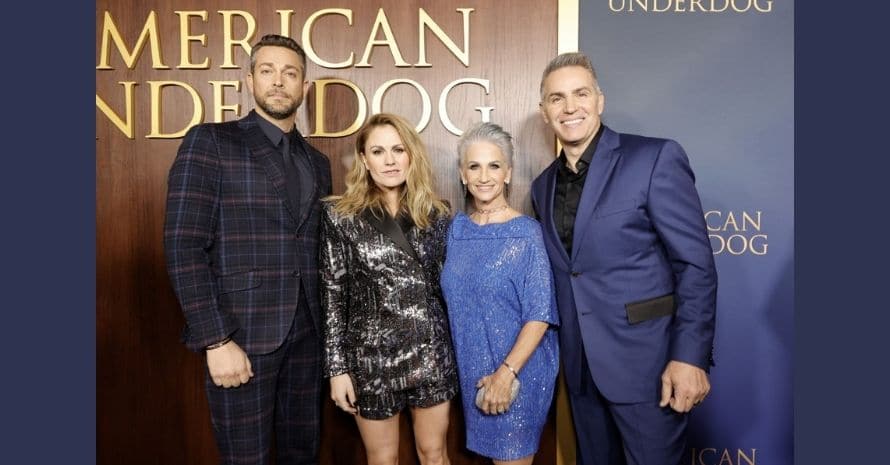Actors Zachary Levi, from left, and Anna Paquin join Brenda and Kurt Warner for the Dec. 15 premiere of “American Underdog,” a film about Kurt Warner’s unlikely path to the NFL. (Rodin Eckenroth/FilmMagic)
UNI-Dome missing; Vets Auditorium not real barnyard
As a Christmas Day present, my two college student daughters tagged along to see “American Underdog.” The movie bio tells the Cinderella story of Kurt Warner, the NFL quarterback who bucked the odds to win a Super Bowl and induction into the Pro Football Hall of Fame.
The motion picture is based on the book “All Things Possible: My Story of Faith, Football and the First Miracle Season,” written by sportswriter Michael Silver with input from Kurt Warner and his family.
Full disclosure: Warner grew up in my hometown of Cedar Rapids, Iowa. We’re about 11 years apart in age. I started following his career about the time he broke through in the mid-1990s playing QB for the Iowa Barnstormers, a member of the Arena Football League.
It’s an enjoyable film and not too sappy considering the storybook circumstances tied to Warner’s unpredictable career.
Anna Paquin is especially good playing Brenda Warner, Kurt’s wife. She captures the emotional roller-coaster well balancing single motherhood and her love for Warner, magnified by her parents’ death in an Arkansas tornado.
The real star is Hayden Zaller, the blind actor who plays Zach Warner, Brenda’s blind son from her first marriage. Credit directors Jon and Andrew Erwin for staying true to life for that aspect of the film.
For me, the movie makes several personal connections, and as a venues geek, I was curious to see how the multiple facilities Warner played in over the course of his career would be represented on screen.
Warner played college football at the University of Northern Iowa. The Football Championship Subdivision school plays home games at the UNI-Dome, an indoor facility with 16,324 seats. Two years after it opened in 1976, I played my last high school football game at the UNI-Dome. (My team, Kennedy High School, lost to Cedar Falls High).
To many Iowans, the venue represents more than just a movie footnote. It’s iconic. For the past 45 years, the UNI-Dome has been the home of Iowa’s high school football playoffs as well as UNI football, and it’s played host to many stadium concerts such as the Rolling Stones, The Who, The Eagles and Fleetwood Mac.
Unfortunately, the UNI-Dome doesn’t really exist in the movie, except for the scene where eagle-eyed viewers can see Warner piecing together a highlight reel on videocassette of big plays (in real life) he made at the indoor venue.
Instead, we see Warner, played by actor Zachary Levi, playing college ball outdoors in a small stadium in winter weather, a red flag for Iowans and college football enthusiasts familiar with Northern Iowa’s dome.
To an extent, it undermines the film’s credibility.
According to The Cinemaholic website, Jim Norick Arena at State Fair Park in Oklahoma City; the University of Central Oklahoma’s Chad Richison Stadium; and Ford Center at The Star, the Dallas Cowboys’ 12,000-capacity indoor stadium at their practice facility in Frisco, Texas, were used for the football action scenes.
I get it; it’s showbiz and they take artistic license to create a compelling story. For me, it was a curious omission to not show Warner playing indoors in college regardless of which venue was featured in those scenes.
What made me shake my head was the portion of the film devoted to Warner’s AFL career.
The Barnstormers of that era played home games at the old Veterans Memorial Auditorium in Des Moines, Iowa. I went to college at Drake University in Iowa’s capital city, covered men’s basketball for the school paper at that arena and graduated there.
To locals, the 12,000-capacity arena was affectionately known as “The Barn.” Vets Auditorium opened in 1955. It’s got a lot of history. Elvis performed there in one of his final concerts before he died in 1977.
Seventeen years ago, after Wells Fargo Arena opened in downtown Des Moines, Vets was converted to Hy-Vee Hall, a convention and trade show facility run by Spectra. (Ironically, it’s named for the Iowa-based grocery store chain where Warner stocked shelves at a store in Cedar Falls while struggling to make it as a pro quarterback).
In the movie, Warner and his Barnstormer teammates walk through a permanent livestock facility attached to Vets, which in real life, was not part of the layout of the facility. They pass by farm animals on their way to the field. Wow, that’s a stretch. I had to laugh at that Midwestern stereotype.
Toward the end of the film, the viewer is taken through Warner’s first NFL start for the St. Louis Rams, whose home venue was the Trans World Dome, now The Dome at America’s Center. Those sequences were shot at Ford Center, which presents a more realistic scenario.
The one real noteworthy omission is tied to Warner’s arena league coach.
Jim Foster, the Iowa native who invented the game of arena football and was the Barnstormers’ original owner, is depicted in the movie as their head coach. He’s played by Bruce McGill, aka D-Day from “Animal House.”
In reality, John Gregory was the team’s head coach and gave Warner the opportunity to showcase his skills in the arena league, Warner ultimately signed an NFL contract with the Rams and played in three Super Bowls (one with the Arizona Cardinals) over a 12-year career.
Gregory took the Barnstormers to consecutive ArenaBowls with Warner at QB and ranks among that sport’s most successful coaches, but he’s missing from the film.
But hey, it’s Hollywood and I’m sure John Gregory is content knowing his key role in the Kurt Warner story.







